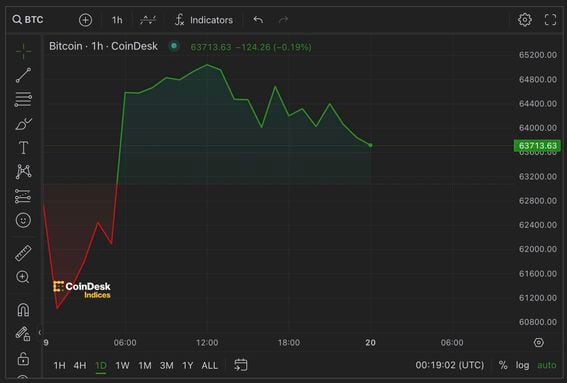

10 Years of Decentralizing the Future
May 29-31, 2024 – Austin, TexasThe biggest and most established global hub for everything crypto, blockchain and Web3.Register Now
Bitcoin (BTC) held steady around $63,700 in the aftermath of the cryptocurrency’s fourth halving, an event that upends the economics for the miners who power the Bitcoin ecosystem.
BTC recently barely moved from its level right before the 840,000th Bitcoin block was mined just as Saturday began in UTC time. Bitcoin had slumped as low as $59,685 on Friday before rebounding above $65,000.
The halving has historically been a precursor to a rally in the price of bitcoin, with the last one, in May 2020, giving way to a run up from $9,500 to $65,000 during the subsequent year.
But this time, bitcoin has already embarked on a momentous rally to record highs, rising from $15,500 in late 2022 to $73,680, helped by optimism around the approval of spot bitcoin ETFs in the U.S. and then then the ensuing enthusiasm after they began trading in January.
On Thursday, JPMorgan said that it expected bitcoin to drop following the halving as it remained in “overbought conditions” based on the high level of open interest in bitcoin futures. Goldman Sachs added that in order for bitcoin to emulate the success of previous cycles following halving events, macro conditions need to be supportive of risk-taking.
Bitcoin has traded between $59,600 and $73,860 since Feb. 28 with the upside of the range being protected this week alongside the backdrop of rising conflict in Israel, which has had a knock-on effect across all capital markets.
A sell-off on April 12 from $71,000 to $60,000 wiped out $4 billion in open interest from the bitcoin market, according to Coinalyze. The figure across all exchanges excluding CME is $16.1 billion.
Edited by Nick Baker.

